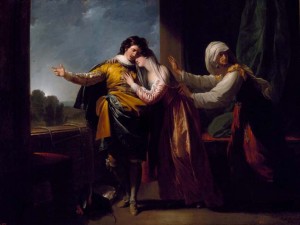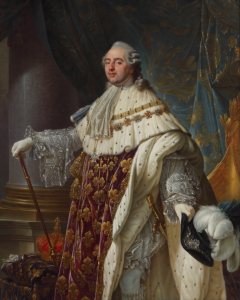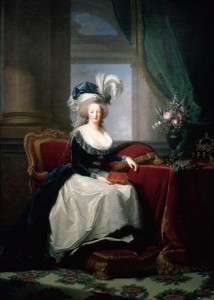Affairs of the heart have long been at the heart of art in all cultures. NOMA’s galleries are filled with amorous scenes in painting and sculpture, along with works created through loving partnerships or intended to spark romance. This Valentine’s Day, make a date with yourself, a loved one, or friends and explore the galleries through the lens of love. While the Besthoff Sculpture Garden closes at 5 pm on February 14, the galleries, Cafe NOMA, and the Museum Shop will be open until 9 pm. Jazz vocalist Meghan Stewart will perform in the Great Hall from 5:30 to 8:30 pm as part of Friday Nights at NOMA. Here we highlight six works centered upon famous couples, and one designed to ensure marital harmony.

Benjamin West (American, 1738–1820), Romeo and Juliet, 1778, Oil on canvas, Museum purchase, Women’s Volunteer Committee Fund, 73.33
ROMEO AND JULIET
William Shakespeare’s star-crossed lovers appear in a painting by American-born artist Benjamin West, created in London in 1778 as the American Revolution raged across the Atlantic. West was a British-colonial Pennsylvanian by birth in 1738 and claimed in his memoir that when he was a child, Native Americans showed him how to paint by mixing clay with bear grease in a pot. Successful in his early career as primarily a portrait painter in Philadelphia, West embarked on a Grand Tour of Italy in 1760 to copy masterpieces and learn from resident neo-classical artists. In 1763 he arrived in London, where he would remain the rest of his life, earning fame and the title “America’s Raphael.”
At a time when most artists painted allegorical scenes of ancient Greece and Rome, West often painted modern battles and figures in period clothing. He turned to plays to illustrate contemporary social issues, especially as public theater became increasingly popular in the United States in the late eighteenth century. The agony of Romeo and Juliet, who first appeared on the printed page in 1595, evoked the roiling tensions between England and the insurgent United States.

An installations in the Lupin Decorative Arts Gallery includes midcentury modern furniture by such designers as Charles and Ray Eames, Piero Fornasetti, Norman Churner, Arne Jacobsen, and Isamu Noguchi.
CHARLES AND RAY EAMES
The husband-and-wife team of Charles and Ray Eames became synonymous with midcentury modern design in the postwar United States. The “Eames look,” most recognized in furniture, can be defined as both playful and functional, sleek, sophisticated, and beautifully simple, but the couple also made their mark in architecture, industrial design, and both graphic and photographic arts. The two met at the Cranbrook Academy in Bloomfield Hills, Michigan, where Bernice “Ray” Kaiser, an aspiring abstract painter, enrolled as a student in 1940. Charles was an instructor following a fellowship as recommended by preeminent architect Eliel Saarinen. He proposed to her in a heartfelt letter to that read, “I cannot promise to support us very well, but if given the chance, I will sure as hell try,” followed by a drawing of a hand with an arrow pointing to the second digit, asking “What size is this finger?” A month later, they wed, followed by a road trip to Los Angeles. They collected tumbleweeds along the way, which they would hang from the ceiling of their California home.
He would initially work as a set designer for MGM Studios, absconding with wood and glue that he would take home so that the two of them could experiment with plywood molding techniques. They would found Eames Office in 1943, over time securing lucrative contracts from Herman Miller, IBM, Boeing, and Vitra, among others. Their innovative enterprise that would function for more than four decades. The Eameses once turned down the opportunity to redesign the logo for Budweiser beer with Charles claiming there was no good reason to change the existing design. One of Charles’s favourite quotes was “at all times love and discipline have led to a beautiful environment and a good life.” He died in 1978, and she would follow in 1988 on the exact same date of August 21.

Francesco Guardi (Italian, Venetian, 1712–c. 1793), Esther at the Throne of Ahasuerus (detail), c. 1747–1753, Oil on canvas, Gift of Mr. and Mrs. Harold L. Bache in memory of Mrs. Sigmund Odenheimer, 62.9
KING AHASUERUS AND QUEEN ESTHER
Esther is one of only two women for whom a book of the Bible is named (Ruth being the other). She is credited with saving the lives of her fellow Babylonian Jews from a planned slaughter in the fifth century BCE. Esther was a member of the harem of Persian ruler Ahasuerus (Xerxes I) when found herself elevated to the throne after the king banished his first wife, Vashti, for failing to heed a command to flaunt herself—some interpret as naked—at a royal banquet. (Among many feminist scholars who have lauded this act of self dignity, American author Harriet Beecher Stowe called Vashti’s defiance the “first stand for woman’s rights.”) Asahuerus summoned his concubines to parade themselves in a beauty pageant, from which he selected Esther, a courtesan of concealed Jewish ancestry, to become the new queen based upon her ravishing appearance.
According to the Old Testament, the king’s chief advisor, Haman, despised Esther’s cousin and guardian, Mordecai. In a vengeful death wish, Haman plotted a massacre of all Jews in the kingdom. In an act of bravery, Esther perilously revealed her religious identity to the king and pleaded that her people be spared while pointing to Haman as the murderous instigator. Ahasuerus granted mercy, whereupon Haman threw himself at Esther’s feet, a sudden act that the king interpreted as an attack upon his wife. Haman was ordered executed, Mordecai became the new royal advisor, and the Jews were allowed to rise up against their enemies. The fortuitous turn of events is commemorated yearly on the Jewish holiday of Purim.

Antoine François Callet (French, 1741–1823), Portrait of Louis XVi, c. 1782–1783, Oil on canvas, Museum purchase in honor of the 75th anniversary, 86.90

Elisabeth Louise Vigée Le Brun (French, 1755–1842), Portrait of Marie Antoinette, Queen of France, c. 1788, Oil on canvas, Museum purchase, Women’s Volunteer Committee and Carrie Heiderich Fund, 85.90
KING LOUIS XVI AND QUEEN MARIE-ANTOINETTE
The last couple to serve as royal heads of state in France—before literally losing their heads to the guillotine—was King Louis XVI and Queen Marie-Antoinette. In 1756, after three centuries of animosity, France and Austria declared a truce and formed an alliance. To further bind relations between the the Bourbon and Hapsburg empires, King Louis XV of France and Empress Maria Theresa of Austria arranged for the future marriage of their respective son and daughter, who were toddlers at the time.
Twelve years later, Marie-Antoinette, age 14, wedded Louis XVI, age 15, in a lavish ceremony at Versailles. On her prenuptial journey to France, Marie was required to disrobe at the border and don an elaborate outfit befitting the French royal court, replete with a towering wig and a ghostly-white powdered face. Her wedding dress dazzled, sewn from specially-woven silver cloth bejeweled in diamonds, and guests never took their eyes off the bridal dauphine—including all the way to the honeymoon boudoir. In the presence of the entire Court, she and the dauphin climbed into bed together with expectations among their eyewitnesses that an heir would join the family’s ranks in short order. A child was not conceived for seven years, leading to much gossip within the circle of elites.
The couple never proved to be wholly compatible, and Marie engaged in an affair with Alex von Fersen, a Swedish diplomat who had fought in the American Revolution. In a break from tradition, Louis was not known to have taken a mistress. When revolution swept France in 1789, the royal family was imprisoned and the monarchy was abolished in 1792. The king was executed in January 1793. Marie’s public beheading took place nine months later. Legions of songs, known as complaintes, decrying her alleged profligate lifestyle were published in the aftermath, one of which spoke about her alleged funneling of the public treasury to Austria: “I drain your finances,/ And I laugh at your pains:/ By my foolish expenditure / France is a tomb.”

Baule Peoples, Côte d’Ivoire, Spirit Spouse (asie usu), Wood, glass, Bequest of Victor K. Kiam, 77.238
SPIRIT SPOUSE (asie usu)
All married couples are bound to confront differences. When vows of for better or for worse slide toward the negative, the Baule culture of Ghana and Côte d’Ivoire seek the intervention of a shaman who may recommend connecting with a “spirit spouse.” The Baule believe that every husband and every wife has a spirit spouse of the opposite sex living in the blolo, an alternate otherworld where the spirits of newborns and the deceased live. When relationships in this world are not going well, this is because a spirit spouse is angry and causing problems. To resolve the strife, artisans will create a blolo bla (female) spirit spouse figure carved for the husband and a blolo bian (male) spirit spouse figure carved for the wife. The couple is then told to perform rituals to their spirit spouses to correct the problems.
Communication with spirit spouses is believed to take place in one’s dreams, and the owner of a spirit spouse will hold his or her figure at arm’s length to talk with the figure and respond to the dreams. The figure is placed in a private shrine, and the owner makes offerings to the spirit spouse of food, oils, clothes, jewelry, and/or money on a regular basis to appease these jealous spirits.
NOMA members inspire the love of art in every visitor who walks into the Great Hall or through the gates of the Sydney and Walda Besthoff Sculpture Garden.
In addition to enjoying benefits like special members’ previews of exhibitions, free wellness classes surrounded by sculptures, and a complimentary subscription to NOMA Magazine, our members enable schoolchildren to discover the Old Masters, community members to engage with world-class art and local artists, and NOMA’s curators to present innovative and provocative exhibitions year after year.
▶ JOIN TODAY
